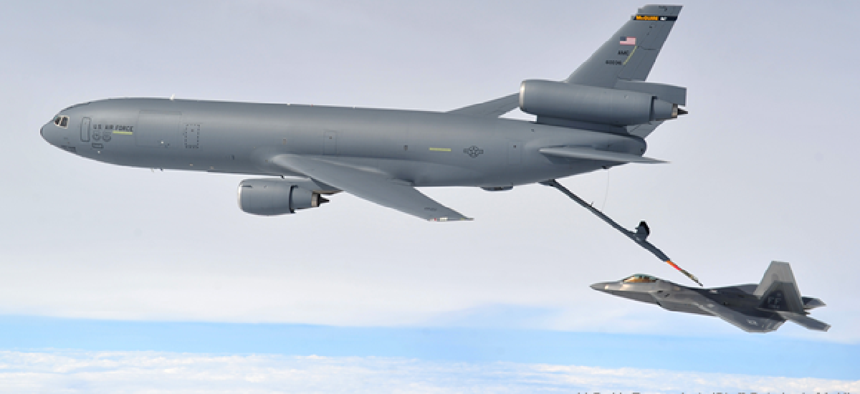AF self-starters build load balancing app for refueling


Connecting state and local government leaders
A team from the Air Force’s Software Engineering Office taught themselves the basics of app development well enough to build an app that now saves AF tankers over 30 minutes on in-flight refueling operations.
When you’re an Air Force boom operator, time and accuracy come first. It’s the boom operator’s job to safely refuel aircraft in flight, which requires quick and exact weight and balance calculations during the fuel transfer.
Project at a glance
Project: KC-10 Load Management System, an iOS-based weight and balance application
Office: Air Mobility Command, U.S. Air Force
Technology used: iOS, Apple XCode, Fortify Security Scanner, Clang Scanner, Apple iPad
Time To Implementation: 6 months
Before: Boom operators were using aging Dell PDAs to help determine weight and balance. The existing application was slow and outdated.
After: Boom operators use the custom-developed KC-10 Load Management System on new iPads to quickly and more accurately calculate weight and balance.
For years, boom operators working on the Air Mobility Command’s 59 tanker fleet were doing the best they could with aging software and personal digital assistants to run their calculations. It took an average of 46 minutes to perform the computations, and each calculation resulted in an average of seven to 10 minor errors.
When the PDAs began breaking, it became clear it was time for a new solution. After deciding on a switch to iPads for its flight crews, the AMC requested a feasibility study to determine whether the AMC’s own Software Engineering Office could develop an iOS-based mobile application for weight and balance computations.
But while the Software Engineering Office’s 39 employees routinely engineer, maintain and update custom software for many parts of the Air Force as well as the Defense Department and U.S. Transportation Command, very few had any experience developing apps for iOS.
Staff Sergeant Ryan Woods, lead developer for the project, suggested that the team explore free or low-cost training alternatives. Two developers, in addition to Woods himself, ended up taking an online course offered by Stanford University. The course, plus plenty of trial and error, gave Woods and his team a good foundation for app building.
In addition to having to learn iOS development, none of the team members had experience developing applications specifically for the KC-10 aircraft, which has its own unique specifications. To get up to speed, the team talked to KC-10 load and boom operators and consulted hundreds of pages of flight manuals and technical orders.
By the time they were ready to design and code the application, they had immersed themselves in mathematical calculations and load configurations. “We kept in close contact with our customers to keep on top of the requirements and took whatever calculations we could from the old version, but there was a lot that couldn’t be ported because of the operating system. There was a big learning curve,” Woods said.
Woods and the other two developers then started developing code in earnest, using tools that were either free or already existed in the office. They included Apple’s XCode freeware, existing Fortify Security Scanner licenses, a built-in Clang scanner and a detached functional testing office.
It took the team six months from the time they started learning app development until the first version was released. The application, with more than 19,000 lines of code, was the first iOS application of its kind for the Air Force.
Since boom operators started using the iOS KC-10 Load Management System, time has been saved and accuracy improved. The new system, running on iPads, reduced a 46 minute calculation to five minutes. It also saved 41 minutes per flight, which translates to 4,189 hours per year. The app also has decreased the error margin from 7-10 minor errors per flight to less than 1, reducing annual errors by about 49,000.
The news of the app’s success spread fast. The team already has received preliminary requests to develop a similar app for the Coast Guard C-130H, KC-135, KC-46 and HC-140A.
The project has also triggered development of additional iOS-based apps for pain management, power management and a user testing management system for qualifying Air Crew members. The software team also sent the KC-10 L Load Management System code to the 578th Software Maintenance Squadron when it undertook a similar development effort for the C-5 aircraft. They were able to use the iOS template Wi-Fi printing functionality, saving 225 hours and $30,000.
NEXT STORY: NOAA updates Whale Alert app




